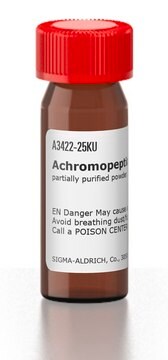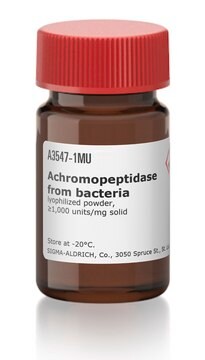A3611
Arachidonic acid
from non-animal source, ≥98.5% (GC)
Sinónimos:
cis,cis,cis,cis-5,8,11,14-Eicosatetraenoic acid, Eicosa-5Z,8Z,11Z,14Z-tetraenoic acid, Immunocytophyte
About This Item
Productos recomendados
biological source
non-animal source
Quality Level
assay
≥98.5% (GC)
form
liquid
refractive index
n20/D 1.4872 (lit.)
bp
169-171 °C/0.15 mmHg (lit.)
mp
−49 °C (lit.)
density
0.922 g/mL at 25 °C (lit.)
functional group
carboxylic acid
lipid type
omega FAs
shipped in
dry ice
storage temp.
−20°C
SMILES string
OC(CCC/C=C\C/C=C\C/C=C\C/C=C\CCCCC)=O
InChI
1S/C20H32O2/c1-2-3-4-5-6-7-8-9-10-11-12-13-14-15-16-17-18-19-20(21)22/h6-7,9-10,12-13,15-16H,2-5,8,11,14,17-19H2,1H3,(H,21,22)/b7-6-,10-9-,13-12-,16-15-
InChI key
YZXBAPSDXZZRGB-DOFZRALJSA-N
¿Está buscando productos similares? Visita Guía de comparación de productos
Application
<li><strong>Molecular Mechanisms Associated with the Inhibitory Role of Long Chain n-3 PUFA in Colorectal Cancer:</strong> This study discusses the effects of long-chain polyunsaturated fatty acids, like arachidonic acid, on colorectal cancer mechanisms. The research focuses on the anti-inflammatory and cancer inhibitory roles through the modulation of lipid metabolism and signal transduction pathways (Jayathilake et al., 2024).</li>
<li><strong>Zhilining Formula alleviates DSS-induced colitis through suppressing inflammation and gut barrier dysfunction via the AHR/NF-Bp65 axis:</strong> This article presents arachidonic acid′s role in the suppression of inflammation and restoration of gut barrier function, crucial for understanding inflammatory diseases and developing therapeutic strategies (Zhou et al., 2024).</li>
<li><strong>5,6-diHETE lactone (EPA-L) mediates hypertensive microvascular dilation by activating the endothelial GPR-PLC-IP(3) signaling pathway:</strong> Explores the cardiovascular implications of arachidonic acid metabolites, specifically their role in microvascular responses, which could influence hypertension treatment strategies (Asulin et al., 2024).</li>
</ul>
Biochem/physiol Actions
Packaging
signalword
Warning
hcodes
Hazard Classifications
Eye Irrit. 2 - Skin Irrit. 2
Storage Class
10 - Combustible liquids
wgk_germany
WGK 3
flash_point_f
235.4 °F - closed cup
flash_point_c
113 °C - closed cup
Certificados de análisis (COA)
Busque Certificados de análisis (COA) introduciendo el número de lote del producto. Los números de lote se encuentran en la etiqueta del producto después de las palabras «Lot» o «Batch»
¿Ya tiene este producto?
Encuentre la documentación para los productos que ha comprado recientemente en la Biblioteca de documentos.
Los clientes también vieron
Nuestro equipo de científicos tiene experiencia en todas las áreas de investigación: Ciencias de la vida, Ciencia de los materiales, Síntesis química, Cromatografía, Analítica y muchas otras.
Póngase en contacto con el Servicio técnico









